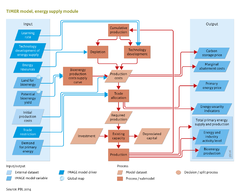Energy supply/Description: Difference between revisions
Jump to navigation
Jump to search
No edit summary |
No edit summary |
||
| Line 57: | Line 57: | ||
To reflect geographical, political and other constraints in the interregional fuel trade, an additional 'cost' is added to simulate trade barriers between regions (this costs factor is determined by calibration). Natural gas is transported by pipeline or liquid-natural gas ({{abbrTemplate|LNG}}) tanker, depending on distance, with pipeline more attractive for short distances. In order to account for cartel behaviour, the model compares production costs with and without unrestricted trade. Regions that can supply at lower costs than the average production costs in importing regions (a threshold of 60% is used) are assumed to supply oil at a price only slightly below the production costs of the importing regions. Although also this rule is implemented in a generic form for all energy carriers, it is only effective for oil, where the behaviour of the OPEC cartel is simulated to some extent. | To reflect geographical, political and other constraints in the interregional fuel trade, an additional 'cost' is added to simulate trade barriers between regions (this costs factor is determined by calibration). Natural gas is transported by pipeline or liquid-natural gas ({{abbrTemplate|LNG}}) tanker, depending on distance, with pipeline more attractive for short distances. In order to account for cartel behaviour, the model compares production costs with and without unrestricted trade. Regions that can supply at lower costs than the average production costs in importing regions (a threshold of 60% is used) are assumed to supply oil at a price only slightly below the production costs of the importing regions. Although also this rule is implemented in a generic form for all energy carriers, it is only effective for oil, where the behaviour of the OPEC cartel is simulated to some extent. | ||
===Bioenergy=== | |||
The structure of the biomass submodule is similar to that for fossil fuel supply, but with the following differences ([[Hoogwijk, 2004]]): | |||
* Depletion of bioenergy is not governed by cumulative production but by the degree to which available land is used for commercial energy crops. | |||
* The total amount of potentially available bioenergy is derived from bioenergy crop yields calculated on a 0.5x0.5 degree grid with the IMAGE [[Crops and grass|crop model]] for various land-use scenarios for the 21st century. Potential supply is restricted on the basis of a set of criteria, the most important of which is that bioenergy crops can only be on abandoned agricultural land and on part of the natural grassland. The costs of primary bioenergy crops (woody, maize and sugar cane) are calculated with a Cobb-Douglas production function using labour , land rent and capital costs as inputs. The land costs are based on average regional income levels per km2, which was found to be a reasonable proxy for regional differences in land rent costs. The production functions are calibrated to empirical data ([[Hoogwijk, 2004]]). | |||
* The model describes the conversion of biomass (including residues, in addition to wood crops, maize and sugar cane) to two generic secondary fuel types: bio-solid fuels used in the industry and power sectors; and liquid fuel used mostly in the transport sector. | |||
* The trade and allocation of biofuel production to regions is determined by optimisation. An optimal mix of bio-solid and bio-liquid fuel supply across regions is calculated, using the prices of the previous time step to calculate the demand. | |||
The production costs for bioenergy are represented by the costs of feedstock and conversion. Feedstock costs increase with actual production as a result of depletion, while conversion costs decrease with cumulative production as a result of ‘learning by doing’. Feedstock costs include the costs of land, labour and capital, while conversion costs include capital, {{abbrTemplate|O&M}} and energy use in this process. For both steps, the associated greenhouse gas emissions (related to deforestation, N2O from fertilisers, energy) are estimated (see Component [[Emissions]]), and are subject to carbon tax, where relevant. | |||
===Other renewable energy=== | |||
Potential supply of renewable energy (wind, solar and bioenergy) is estimated generically as follows ([[Hoogwijk, 2004]]; [[De Vries et al., 2007]]): | |||
# Physical and geographical data for the regions considered are collected on a 0.5x0.5 degree grid. The characteristics of wind speed, insulation and monthly variation are taken from the digital database constructed by the Climate Research Unit ([[New et al., 1997]]). | |||
# The model assesses the part of the grid cell that can be used for energy production, given its physical–geographic (terrain, habitation) and socio-geographical (location, acceptability) characteristics. This leads to an estimate of the geographical potential. Several of these factors are scenario-dependent. The geographical potential for biomass production from energy crops is estimated using suitability/availability factors taking account of competing land-use options and the harvested rain-fed yield of energy crops. | |||
# Next, we assume that only part of the geographical potential can be used due to limited conversion efficiency and maximum power density, This result of accounting for these conversion efficiencies is referred to as the technical potential. | |||
# The final step is to relate the technical potential to on-site production costs. Information at grid level is sorted and used as supply cost curves to reflect the assumption that the lowest cost locations are exploited first. Supply cost curves are used dynamically and change over time as a result of the learning effect. | |||
}} | }} | ||
Revision as of 17:12, 22 May 2014
Parts of Energy supply/Description
| Component is implemented in: |
|
| Related IMAGE components |
| Projects/Applications |
| Key publications |
| References |
